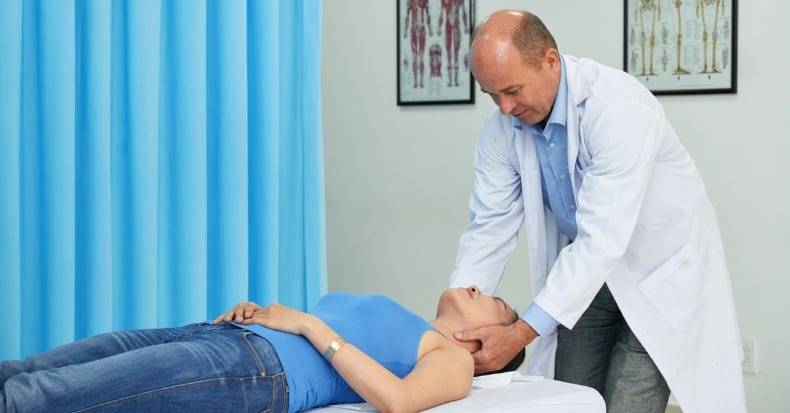British Medical Journal;326:911; April 26, 2003
Ingeborg B C Korthals-de Bos, Jan L Hoving, Maurits W van Tulder, Maureen P M H Rutten-van Mölken, Herman J Adèr, Henrica C W de Vet, Bart W Koes, Hindrik Vondeling, Lex M Bouter,
FROM ABSTRACT:
Objective: To evaluate the cost effectiveness of physiotherapy, manual therapy, and care by a general practitioner for patients with neck pain.
Design: Economic evaluation alongside a randomized controlled trial.
Participants: 183 patients with neck pain for at least two weeks recruited by 42 general practitioners and randomly allocated to manual therapy (n=60, spinal mobilization), physiotherapy (n=59, mainly exercise), or general practitioner care (n=64, counseling, education, and drugs).
Main outcome measures: Clinical outcomes were perceived recovery, intensity of pain, functional disability, and quality of life.
Direct and indirect costs were measured by means of cost diaries that were kept by patients for one year.
Results: The manual therapy group showed a faster improvement than the physiotherapy group and the general practitioner care group up to 26 weeks, but differences were negligible by follow up at 52 weeks.
The total costs of manual therapy were around one third of the costs of physiotherapy and general practitioner care.
These differences were significant.
The cost effectiveness ratios and the cost utility ratios showed that manual therapy was less costly and more effective than physiotherapy or general practitioner care.
Conclusions: Manual therapy (spinal mobilization) is more effective and less costly for treating neck pain than physiotherapy or care by a general practitioner.
Manual therapy is more effective and less costly than physiotherapy or care by a general practitioner for treating neck pain.
Patients undergoing manual therapy recovered more quickly than those undergoing the other interventions.
THESE AUTHORS ALSO NOTE:
Neck pain is a common condition, affecting about a sixth of men and a quarter of women.
There is a need to determine the most cost effective intervention for neck pain.
These authors used a sample size that would clinically detect important difference of 25% in perceived recovery between groups.
In this study, manual therapy consisted of hands-on techniques (muscular mobilization, specific articular mobilization, coordination or stabilization).
“Spinal mobilization was defined as low velocity passive movements within or at the limit of joint range of motion.”
“Spinal manipulation (low amplitude, high velocity techniques) was not provided.”
“Chiropractors, osteopaths, and physiotherapists use mobilization and manipulation techniques.”
“In our trial, manual therapy was applied by six registered manual therapists who had followed a 3 year curriculum in manual therapy after training in physiotherapy. Treatment sessions lasting 45 minutes were scheduled once a week, with a maximum of six sessions.”
“Physiotherapy was applied by five physiotherapists and consisted of individualized exercise therapy, including active and postural or relaxation exercises, stretching, and functional exercises.”
“Treatment sessions lasting 30 minutes were scheduled twice a week, with a maximum of 12 sessions.”
General practitioner care as to encouraged the patient to wait for spontaneous recovery, given Cox-2 inhibitor drugs or non-steroidal anti-inflammatory drugs.
“Clinical outcomes were perceived recovery, intensity of pain, functional disability, and utility.”
EFFECTS OF INTERVENTIONS
“Manual therapy was the most effective treatment.”
Recovery rates after seven weeks in the manual therapy group was 68%.
Recovery rates after seven weeks in the physiotherapy group was 51%.
Recovery rates after seven weeks in the general practitioner care group was 36%.
During the follow up period of 52 weeks, 37% of the patients in the manual therapy group took over the counter drugs compared with almost 50% of patients in both the physiotherapy group and the general practitioner care groups. [Manual therapy resulted in reduced drug use].
“Nine patients in the manual therapy group reported absenteeism from paid work owing to neck pain compared with 12 patients in the physiotherapy group and 15 patients in the general practitioner care group.” [Again, manual therapy was best].
“Absenteeism from unpaid work was reported by 11 patients in the manual therapy group, 18 patients in the physiotherapy group, and 15 patients in the general practitioner care group.”
“The total costs in the manual therapy group were around one third of the costs in the physiotherapy and general practitioner care groups.” [IMPORTANT]
“Total direct, indirect, and total costs were statistically significantly lower in the manual therapy group than in the physiotherapy and general practitioner care groups.” [IMPORTANT]
“Manual therapy is associated with a larger improvement in pain and lower costs.” [IMPORTANT]
“Manual therapy for the treatment of neck pain was more cost effective than physiotherapy or care by a general practitioner.” [IMPORTANT]
“Manual therapy had significantly lower costs and slightly better effects at 52 weeks compared with physiotherapy and general practitioner care.” [IMPORTANT]
“The clinical outcome measures showed that manual therapy resulted in faster recovery than physiotherapy and general practitioner care up to 26 weeks.”
“The acceptability curve for pain intensity comparing manual therapy with physiotherapy showed that at a ceiling ratio of zero there was still a 98% probability that manual therapy was cost effective.”
“Our economic evaluation alongside a pragmatic randomized controlled trial showed manual therapy to be more cost effective than physiotherapy and continued care provided by a general practitioner in the treatment of non-specific neck pain.”
KEY POINT FROM THIS ARTICLE
(1) Manual therapy achieves the best recovery rates, the lowest use of drugs, the least time off work, and is more cost effective compared to drugs and physiotherapy directed active exercises.



